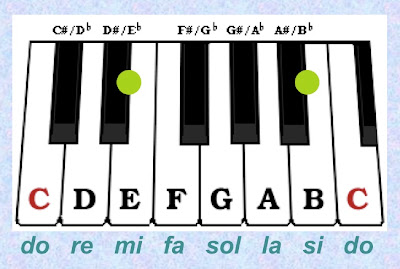As the above explanation sounds like technobabble, for the benefit of those students who have no knowledge of Western music theory, I usually describe the neutral third as
the interval, or simply distance, between do and the mysterious tone which is located between the black mi and the white mi.I also prepare on the PowerPoint slide a wee diagram of the piano keyboard and three sound clips so that students can 'see' and 'hear' clearly what I refer to.

This clip plays do-re-mi-fa-sol with mi on the white key.
This clip plays do-re-mi-fa-sol with mi on the black key.
This clip plays do-re-mi-fa-sol with mi, something between black and white keys that can't be produced on the Western piano.
The interval between do on the white key and this mysterious mi is the so-called neutral third. In music of the Arab world, one can also hear another similar tone between the black si and the white si, and thus the scale below.

This clip plays do-re-mi-fa-sol-la-si-do with the mysterious mi and si.
So, dear readers, do you recognise the sound characteristic of the neutral third?





2 comments:
這樣子是不是其他的音之間也有神秘的音?
是的,阿拉伯世界或中亞地區有二十四律,雖然實務上不見得是如西洋律制那般(12 平均律)的平均律。
傳統上來說,這種四分之一音不是 50 音分值 (鋼琴鍵盤上的一個全音為 200 音分值,一個八度是 1200),而是由樂師根據自己所學到的傳承決定。
但現代的中東流行歌曲、通俗音樂中使用的鍵盤(別懷疑,就是 Yamaha 之類的 keyboard),為了演出移調、升降 key 的方便,則真的使用 24 平均律。那些電子樂器上都有小小的機關,可以讓你奏出有自然三度音的音階。
Post a Comment